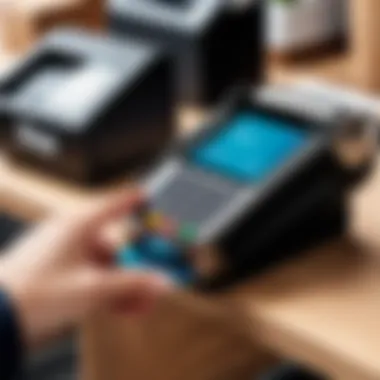Exploring Stripe Card Terminal: Features and Benefits


Intro
The advancement of digital payment systems has transformed how businesses interact with their customers. One of the most significant developments in this domain is the emergence of payment terminals that provide ease and flexibility. Among these, the Stripe Card Terminal stands out. This terminal serves both online and in-person transactions, facilitating a range of payment methods. In this article, we will analyze the key features, benefits, and implementation strategies of the Stripe Card Terminal. The discussion will be relevant for tech-savvy audiences, including IT professionals, business owners, and decision-makers, looking to improve their payment processing.
Key Features
Overview of Features
The Stripe Card Terminal comes with multiple features that enhance its usability and efficiency for businesses.
- Compatibility: The terminal integrates seamlessly with the Stripe ecosystem, allowing businesses to manage payments through a single platform.
- Multiple Payment Options: It supports various payment methods, including credit and debit cards, mobile wallets, and other contactless payments.
- User-Friendly Interface: The interface is designed for easy navigation. This ensures that even staff with minimal training can operate it efficiently.
- Real-Time Reporting: The terminal provides insights into sales in real time, enabling businesses to make informed decisions based on transaction data.
Unique Selling Propositions
The Stripe Card Terminal sets itself apart from competitors through specific unique selling propositions.
- Developer-Friendly: The API capabilities allow developers to customize payment solutions tailored to business needs. This positions the product as a favorite in the tech sphere.
- Security Measures: It adheres to high-security standards, integrating features like encryption and tokenization. This reinforces customer trust during transactions.
- Transparent Pricing: Stripe is known for its clear pricing structure, with no hidden fees. This allows businesses to better forecast costs and manage budgets.
- Scalability: As a business grows, the Stripe Card Terminal can adapt. This is crucial for dynamic environments where transaction volume may increase.
"Choosing the right payment solution is essential. The Stripe Card Terminal combines flexibility and security, making it a strong candidate for diverse businesses."
Pricing Models
Different Pricing Tiers
Understanding the pricing structure is critical for businesses assessing cost-effectiveness. Stripe typically operates on a pay-as-you-go model with varying rates based on transaction types. For card-present transactions, there is a fixed rate per transaction, while online transactions might differ slightly due to processing fees.
- In-Person Transactions: Generally, a fixed rate applies. It allows for budgeting simplicity.
- E-commerce Transactions: A different rate structure is in place for online transactions, reflecting the extended processing involved.
ROI and Cost-Benefit Analysis
When evaluating the ROI of the Stripe Card Terminal, businesses should consider several factors:
- Operational Efficiency: Reduced wait times at checkout can lead to increased customer satisfaction and repeat business.
- Lower Processing Fees: Transparent fees enable businesses to predict costs and potentially save money compared to traditional payment processors.
- Integration Costs: Initial setup costs can be higher for custom implementations, but the long-term benefits often outweigh these upfront expenditures.
Prologue to Stripe Card Terminal
The Stripe Card Terminal serves as a pivotal tool in contemporary payment processing environments. It enables businesses to accept in-person card payments efficiently. In an age where consumer preferences shift towards seamless transactions, understanding the capabilities of the Stripe Card Terminal is essential for any business looking to optimize its payment solutions.
One of the critical elements of the Stripe Card Terminal is its integration capabilities. As businesses increasingly adopt digital solutions, a terminal that meshes well with existing systems can enhance operational efficiency. This integration supports a user-friendly experience, making it easier for staff to manage transactions without a steep learning curve. Moreover, the Stripe Card Terminal supports multiple payment methods, expanding the options for customers while simplifying processes for retailers.
The benefits of adopting the Stripe Card Terminal extend beyond just technology. Cost-effectiveness is another important consideration. Businesses must not only invest in technology but also consider the long-term operational costs of payment processing. As such, the Stripe Card Terminal's pricing model can offer competitive advantages over traditional systems, allowing businesses to retain more revenue.
Challenges do exist, however. Before implementation, businesses need to be mindful of compatibility with their existing hardware and software. Assessing these factors beforehand is crucial to prevent disruptions in service or unexpected expenditures.
In summary, the Stripe Card Terminal plays an integral role in modern payment systems by facilitating easy transactions, supporting multiple payment methods, and offering cost benefits. Understanding these elements ensures that businesses can make informed decisions concerning their payment strategies.
Understanding Payment Processing
Understanding payment processing is integral to the realm of financial transactions today. This article delves into this concept to provide clarity on how various transactions occur, particularly in the context of the Stripe Card Terminal. Knowing the essentials of payment processing helps businesses optimize their operations and enhance customer experiences.
What is Payment Processing?
Payment processing involves a set of actions that facilitate the transfer of money from a customer’s account to a business’s account. When a consumer makes a purchase using a credit or debit card, the payment needs to be authorized, processed, and settled. This transaction typically involves several parties: the cardholder, the merchant, acquiring banks, issuing banks, and payment networks.
The cycle of payment processing is as follows:
- Authorization: The transaction is initiated when the consumer presents their card for payment. The card details are sent to the acquiring bank, which requests validation from the issuing bank.
- Processing: Once the issuing bank confirms the card's validity and available funds, it sends an approval or decline response back through the same network.
- Settlement: If approved, funds are transferred to the merchant's account, typically within a few days.
Understanding this cycle helps businesses choose the right payment solutions and adapt to customer preferences. When businesses grasp these mechanics, it can lead to improved success rates in transactions, thus fostering trust and loyalty among customers.
The Role of Card Terminals
Card terminals play a crucial role in the payment processing landscape. These devices facilitate the capture of payment details securely and efficiently. In the context of physical retail spaces, card terminals allow merchants to accept payments in-person while ensuring compliance with security standards. Stripe Card Terminal, specifically, exemplifies how modern terminals integrate with broader payment systems seamlessly.
Key features of card terminals include:
- Secure Data Capture: They encrypt sensitive card information, thus enhancing protection against fraud.
- Multiple Payment Methods: Most terminals support a variety of payment options, including chip and PIN, contactless, and mobile wallets.
- User Interface: A clear and intuitive interface simplifies the payment experience for both staff and customers.
Overview of Stripe as a Payment Processor
Stripe has emerged as a significant player in the payment processing industry, catering to a diverse range of businesses worldwide. This section explores not just the operational aspect of Stripe, but also the context and relevance of its offerings for potential users, especially those considering adopting the Stripe Card Terminal.
Understanding Stripe as a payment processor involves grasping its historical journey, core values, and its way of addressing market demands. The importance of Stripe lies in its ability to facilitate seamless transactions, making it a go-to solution for many enterprises. Key elements include ease of integration, strong security protocols, and comprehensive analytics.
Company Background
Founded in 2010 by brothers Patrick and John Collison, Stripe has grown exponentially since its inception. Originally designed to simplify online payments, it has expanded its offerings to encompass various payment solutions, including in-person transactions with the Stripe Card Terminal. With a focus on developers, Stripe aims to provide robust APIs that allow businesses to tailor their payment processes according to their unique needs.


The company is headquartered in San Francisco and now operates globally. It has raised substantial capital, which has fueled its growth and innovation. Also, Stripe has established partnerships with major platforms like Shopify, Wix, and Squarespace, enhancing its reach and functionality.
Stripe's Product Suite
Stripe’s product suite is extensive, catering to different aspects of payment processing. Notably, it includes:
- Payment Processing: Supporting various payment methods like credit cards, debit cards, and digital wallets.
- Billing Solutions: Automated billing services for subscriptions and invoicing.
- Fraud Prevention: Advanced security features to protect against fraud.
- Analytics Tools: In-depth insights into transaction trends and customer behavior.
- Support for International Transactions: Easily handle multi-currency transactions and international payments.
The Stripe Card Terminal is integrated into this suite, offering businesses an efficient way to accept payments in-person. The terminal supports multiple payment methods and is designed for seamless use, which aligns perfectly with Stripe's mission to simplify financial transactions across the board.
By understanding Stripe and its offerings, businesses can better assess whether the Stripe Card Terminal meets their specific needs, paving the way for more informed decisions regarding payment solutions.
Key Features of Stripe Card Terminal
The exploration of the Stripe Card Terminal's key features provides a scaffold for understanding its role in modern payment processing. These features shape the user experience and address crucial business needs. They include the terminal's physical design, the range of supported payment methods, and the various mobility and connectivity options available. This multifaceted approach enables businesses to select the best tools for their operations and helps them adapt to an ever-evolving market landscape.
Physical Attributes and Design
The physical attributes of the Stripe Card Terminal contribute significantly to its appeal. Its design is sleek and compact, allowing it to fit seamlessly into various retail environments. This ergonomic design ensures ease of use for customers and staff alike. The key features include a bright display, intuitive touch interface, and a responsive keypad. These attributes enhance user engagement and minimize errors during transactions. Furthermore, the terminal is lightweight, making it portable and suitable for businesses that require mobility, such as food trucks or pop-up shops.
"Design is not just what it looks like and feels like. Design is how it works." - Steve Jobs
Another aspect of its design is the durability factor. The materials used are robust enough to withstand daily wear and tear, which is essential for high-traffic environments. Consequently, businesses can rely on Stripe Card Terminal to perform without frequent replacements, contributing to overall cost savings.
Supported Payment Methods
Stripe Card Terminal supports a variety of payment methods, catering to diverse customer preferences. These methods include:
- Credit and Debit Cards: Standard payment forms that most customers are familiar with.
- Contactless Payments: NFC-enabled transactions through mobile wallets like Apple Pay and Google Pay, providing speed and convenience.
- EMV Chip Payments: Enhancing security by recognizing and validating chip-enabled cards, which is crucial in reducing fraud.
- Alternative Payment Options: Features for global payment methods that may suit international customers.
This flexibility in payment options is vital for businesses aiming to enhance customer satisfaction. By accommodating various payment types, companies can cater to a broader audience. Moreover, as consumer behavior shifts towards digital and contactless payments, this support becomes a critical feature for businesses to remain competitive.
Mobility and Connectivity Options
Mobility is a cornerstone of the Stripe Card Terminal. It offers several options for connectivity that enhance its usability in different settings. The terminal supports both Wi-Fi and Bluetooth connectivity, giving businesses the flexibility to operate in various environments. This is particularly beneficial for sectors such as hospitality and retail, where transactions may occur away from a fixed point of sale.
Moreover, the integration of mobile apps that work in tandem with the card terminal expands its functionality. Users can access transaction history, manage sales reports, and perform real-time analytics through these applications. This capability means that businesses no longer need to rely solely on traditional methods for managing payments and can derive insights directly from the point of sale.
In summary, the key features of the Stripe Card Terminal—from its well-thought-out physical design to its extensive support for payment methods and connectivity options—position it as a valuable asset for businesses seeking efficient payment solutions. Understanding these features is critical for making informed choices in payment processing technology.
Benefits of Using Stripe Card Terminal
The Stripe Card Terminal offers a range of advantages that appeal to various types of businesses. Understanding these benefits helps organizations assess if this solution suits their needs. The important factors are cost-effectiveness, usability, and integration capabilities with existing systems. Each benefit plays a significant role in a business's decision-making process.
Cost-Effectiveness
Cost considerations are vital for decision-makers when evaluating payment processing solutions. The Stripe Card Terminal has competitive transaction rates that can help businesses save money in the long run. With no monthly fees, businesses only pay for transactions processed through the terminal. This pricing model is advantageous, especially for small to medium-sized enterprises that may not have the budget for expensive fixed costs.
Moreover, businesses that utilize Stripe can benefit from lower chargeback fees compared to other providers. This can lead to further savings when managing returns or disputes. Efficient handling of transactions also minimizes the total cost of ownership.
Ease of Use
Another benefit of using the Stripe Card Terminal is its user-friendly interface. Businesses often face challenges when implementing new technologies. However, the Stripe platform is designed to be intuitive. Training staff to use the terminal usually requires minimal time, helping businesses get up and running quickly. The functionality is straightforward, ensuring that employees can accept payments with minimal technical assistance.
In addition, the terminal's design is sleek and portable, which aids in customer interactions. It is less cumbersome than traditional payment methods, providing a more pleasant checkout experience. Overall, simplicity leads to better customer service, a key aspect of maintaining customer loyalty.
Integration with Existing Systems
For businesses with established workflows, integrating new payment systems can present challenges. Stripe Card Terminal is designed to easily integrate with many existing Point of Sale (POS) systems and software applications. The compatibility with various tools means that businesses do not have to overhaul their entire payment processing infrastructure.
Using APIs, developers can customize the integration to fit their specific needs. Whether a retailer or a service provider, having the capability to synchronize data across platforms streamlines operations. This seamless integration helps businesses maintain efficiency without excessive disruptions.
"Cost-effectiveness, ease of use, and integration capabilities make Stripe Card Terminal a strong choice for payment processing needs."
In summary, the benefits of using the Stripe Card Terminal significantly outweigh the potential drawbacks. It provides cost-saving advantages, user-friendly experience, and promotes easy integration, making it an appealing option for various business types.
Considerations Before Implementation
In evaluating the integration of Stripe Card Terminal, it is crucial to examine several key considerations that can significantly impact a business's payment processing setup. Each element discussed below not only shapes the operational efficiency but also safeguards the entire transaction process. Addressing these considerations before actual implementation ensures that businesses can navigate potential challenges effectively.
Hardware Requirements
The hardware requirements for the Stripe Card Terminal must be clearly understood. This terminal necessitates specific hardware devices to ensure a smooth and functional setup. Businesses should be aware of the following components:
- Stripe Card Terminal Unit: Businesses need to procure compatible Stripe terminal devices.
- Compatibility with Existing Systems: Ensure that the terminal can operate seamlessly with current POS systems, or whether updates are necessary.
- Network Connectivity: A stable internet connection via Wi-Fi or Bluetooth is essential. Any disruption in connectivity might lead to failed transactions.
Understanding these hardware aspects prevents delays and frustrations during implementation.
Software Compatibility


Another vital consideration is the software compatibility of the Stripe Card Terminal. The effectiveness of the terminal is closely linked to its integration with existing software environments. Here are some important points to consider:
- POS Software Integration: Ensure the terminal supports the existing point-of-sale software used by the business.
- Payment Processing Integration: The terminal should adequately integrate with payment gateways, allowing for easy processing of transactions.
- Updates and Maintenance: Regular software updates should be monitored to avoid compatibility issues. Keeping software current is crucial for operational security and performance.
Thorough understanding of software compatibility will facilitate a more effective user experience.
Security Compliance
Security compliance is arguably the most critical aspect when implementing the Stripe Card Terminal. Businesses must adhere to strict security standards to protect customer information and prevent fraud. Key security measures include:
- PCI Compliance: The Payment Card Industry Data Security Standard (PCI DSS) outlines essential security features. Adhering to these standards shields businesses from potential liabilities.
- Data Encryption: Ensure that sensitive data is encrypted both in transit and at rest to protect customer data from unauthorized access.
- Regular Security Audits: Conducting routine audits can help identify potential vulnerabilities. By proactively addressing weaknesses, businesses can enhance their overall security stance.
Implementing security protocols not only protects the business but also builds trust with consumers.
Important: Understanding hardware requirements, software compatibility, and security compliance is critical before implementing the Stripe Card Terminal to ensure a seamless integration experience.
Step-by-Step Integration Process
Integrating the Stripe Card Terminal into a business operation is a critical undertaking. This process not only ensures that a business can effectively accept card payments, but it also contributes to overall efficiency and customer satisfaction. A thorough understanding of the integration steps helps in minimizing potential issues. Given the elaborate nature of the integration, clarity and structure become essential.
Setting Up Your Account
The first step in the integration process is setting up your Stripe account. This account acts as the foundation for all payment processing activities. It is crucial to provide accurate information, including your business name, address, and banking details. Completing identity verification is also important. It not only ensures compliance with regulatory requirements but can also speed up the processing times for transactions.
Once the account setup is complete, users gain access to the Stripe Dashboard. This system is where all payment transactions are managed. Here, businesses can track sales activity, view analytics, and manage refund requests. A step not to be overlooked is enabling the necessary APIs. These interfaces connect your account to various systems, particularly the Point of Sale (POS) setup.
Connecting to Your POS System
Integration with the POS system is where the Stripe Card Terminal truly begins to shine. Depending on the specifics of your business model, this step may vary. Most commonly, users will need to install a dedicated application that allows for seamless communication between the card terminal and the POS setup. The installation process usually involves following prompts from the Stripe Dashboard.
During this process, ensure that any existing POS hardware can support the Stripe system. Compatibility can affect performance, so verifying that is essential. Once the connection is established, users may need to configure settings within the POS to facilitate a smooth transaction flow. This could include setting up payment types accepted or enabling features like tipping or splitting payments.
Testing the System
The testing phase is essential before going live. After integrating the Stripe Card Terminal, businesses must verify that it functions as intended. This process involves conducting trial transactions. Start by using a small test amount to see if the transaction is processed correctly. Check both the POS and Stripe Dashboard for updates to ensure synchronization.
Additionally, it's also wise to test various payment methods to ensure everything runs smoothly. This includes credit cards, debit cards, and contactless payments. Identifying and resolving any issues at this stage is vital, as it can prevent complications once the system is in full operation. Furthermore, the testing process can aid in acclimatizing staff to the new system, ensuring they can handle customer transactions confidently.
"Thorough testing not only validates the setup but also boosts employees' confidence in using new systems."
In summary, the step-by-step integration process for the Stripe Card Terminal is structured yet flexible, adapting to diverse business needs. By meticulously setting up the account, connecting with POS systems, and rigorously testing, businesses can ensure a seamless transition into efficient card payment processing.
Comparative Analysis with Competitors
Importance of Comparative Analysis
A comparative analysis of payment processing solutions like Stripe Card Terminal is vital for businesses aiming to optimize their operations. By evaluating Stripe against its competitors, one can understand the nuanced differences in features, costs, and user experience. This not only aids in selecting the best tool for a specific business need but also ensures that investment in technology aligns with long-term business goals. Different sectors may have different priorities, from basic functionality to advanced analytics. Therefore, understanding these distinctions creates a pathway for informed decision-making.
Square vs. Stripe
When looking at Square and Stripe, both platforms provide robust solutions, but they cater to slightly different audiences. Square is known for its all-in-one approach which is user-friendly and ideal for small businesses seeking simplicity. Users can easily access a wide range of tools without extensive setup.
In contrast, Stripe excels in customizability. Its extensive API allows tech-savvy businesses to create tailored experiences. Payment options, international transfers, and flexibility make Stripe a strong choice for companies with more complex needs. Cost structures differ as well; while Square has set rates, Stripe often charges per transaction, which can benefit higher-volume businesses.
PayPal Here vs. Stripe
PayPal Here serves as a significant competitor, focusing on ease of use and familiarity due to PayPal's wide adoption. Its card reader can integrate with existing PayPal accounts, making it attractive for those already within the PayPal ecosystem. However, while it excels in basic transactions, its feature set may fall short compared to Stripe’s advanced offerings such as detailed analytics or subscription management. Stripe’s ability to accommodate large-scale operations often makes it favorable for e-commerce and digital businesses where flexibility and integration options are paramount.
Revel vs. Stripe
Revel Systems targets the restaurant and retail sectors with a robust POS system. It offers built-in inventory and employee management tools, making it an attractive option for businesses with heavy operational needs. However, the cost for utilizing Revel can be significant. In contrast, Stripe provides a leaner model focused explicitly on payments, which can appeal more to startups and online-driven entities. Feature-wise, Stripe's quick adaptability for integration with other software can be a game-changer for businesses aiming to maintain a seamless workflow.
"When it comes to payment solutions, choice is a function of specific business model considerations, making comparative analysis essential for strategic investment."
Summary
In summary, each competitor has its strengths and weaknesses. Square is best for straightforward needs, PayPal Here benefits from brand recognition, and Revel Systems suits specialized markets. Stripe stands out with its customizability and advanced features, making it ideal for businesses looking to scale or require extensive integration capabilities. Evaluating these options equips businesses with the insight needed to select a solution that best meets their unique demands.
Industry Use Cases
The practical applications of Stripe Card Terminal stretch across various industries. Businesses are increasingly adopting this technology to streamline their payment processes and enhance customer experiences. Understanding the specific use cases in different sectors allows organizations to tailor their payment solutions to meet unique operational demands.
Retail Sector
The retail sector benefits significantly from the implementation of Stripe Card Terminal. It provides a seamless transaction experience, enabling stores to process payments swiftly at checkout. The compact design of the card terminal allows employees to move freely, facilitating sales in busy environments. Merchants can accept various payment methods, including contactless cards and mobile wallets, which caters to a diverse customer base.
Key benefits in retail include:
- Improved Customer Satisfaction: Fast transactions reduce waiting times, which enhances the overall shopping experience.
- Inventory Management: Integration with existing POS systems assists in tracking sales and inventory simultaneously.
- Data Insights: Retailers gain access to transaction data which can be used to optimize stock and tailor marketing strategies.
Hospitality Sector


In the hospitality sector, efficiency and customer service are paramount. Stripe Card Terminal meets these needs by allowing businesses to process payments directly at the table or service point. This mobility ensures that the staff can attend to guests more effectively, minimizing disruptions during service. Besides, the ease of accepting tips and split payments boosts staff morale and customer satisfaction.
Relevant considerations for hospitality include:
- Customizable Payments: Guests appreciate flexibility in payment options, which can include splitting bills or adding gratuity.
- Streamlined Operations: Linking the card terminal with reservation and ordering systems facilitates accurate dining experiences.
- Customer Data Management: The terminal can track customer preferences and spending habits, allowing for personalized service offerings.
E-commerce Solutions
For e-commerce businesses, the Stripe Card Terminal plays a vital role in bridging online and offline sales. By allowing retailers to accept in-person payments at pop-up shops or events, companies can explore new sales avenues. Additionally, the ability to manage inventory and customer data across multiple channels ensures a cohesive shopping experience.
Benefits for e-commerce include:
- Enhanced Flexibility: Businesses can operate in various environments, from physical events to online stores.
- Comprehensive Data Analytics: Access to unified data aids in understanding consumer behavior and optimizing marketing strategies.
- Brand Loyalty: Efficient transaction processes help in cultivating customer trust and loyalty.
"Businesses that effectively integrate payment solutions like Stripe Card Terminal can expect not just efficiency but also closer connections with their customers across platforms."
Overall, the versatility of Stripe Card Terminal across different industries illustrates its vital role in modern payment processing. By understanding these industry-specific use cases, businesses can better leverage Stripe’s capabilities to enhance their operations.
Customer Support and Resources
Effective customer support and comprehensive resources are vital components when considering a payment processing solution like Stripe Card Terminal. Businesses operate in a fast-paced environment, and having access to reliable support channels can significantly influence operational efficiency. When issues arise or queries emerge, the ability to reach a knowledgeable support team is crucial.
Understanding the available support channels and the depth of documentation can make all difference in a smooth integration process and ongoing usage.
Available Support Channels
Stripe offers various support channels tailored to meet the needs of different users. The primary support options include:
- Email Support: Users can send their inquiries through email, receiving responses typically within a few hours. This channel is useful for less urgent questions.
- Chat Support: For instant assistance, the chat feature allows users to communicate directly with support representatives. Live chat is beneficial for quick resolutions to pressing issues.
- Phone Support: Premium users can access dedicated phone support, providing an immediate response for critical situations that may require direct interaction.
- Community Forum: The Stripe community forum is an invaluable resource. Users share their experiences, provide advice, and discuss common challenges. Engaging with the community can often uncover solutions that are not obvious through documentation.
These channels ensure that users can find help promptly, reducing downtime and enhancing overall satisfaction with the service.
Documentation and Tutorials
Documentation and tutorials serve as essential resources for users to fully understand and leverage Stripe Card Terminal. The documentation includes:
- API Documentation: Comprehensive guides for developers wanting to integrate Stripe's features seamlessly into their applications. This documentation covers everything from getting started to advanced use cases.
- Integration Guides: Step-by-step tutorials on setting up and connecting the Stripe terminal to different point-of-sale systems. Clear instructions minimize the chance of errors during implementation.
- FAQs and Troubleshooting: A thorough list of frequently asked questions helps users find answers to common problems without needing to contact support.
Furthermore, video tutorials provide visual guidance, enhancing understanding for those who may find text-heavy documentation challenging. This combination of resources empowers users, facilitating a smoother experience when implementing and using Stripe Card Terminal.
"Having robust support and access to documentation can distinctively differentiate a service from its competitors."
Future Trends in Payment Processing
In the evolving landscape of payment processing, understanding future trends is essential for businesses looking to remain competitive. The rapid advancements in technology and shifting consumer behaviors are reshaping how transactions are processed. This section highlights key trends that influence the adoption and implementation of payment solutions, focusing on emerging technologies and consumer behavior shifts. Ultimately, recognizing these trends can guide effective strategic decisions for business owners and decision-makers.
Emerging Technologies
Emerging technologies are playing a crucial role in the transformation of payment processing. Innovations such as blockchain, contactless payments, and artificial intelligence are revolutionizing the industry. These technologies not only streamline transactional processes but also enhance security measures.
- Blockchain Technology: Blockchain offers a transparent and secure way to handle transactions. With decentralized ledgers, businesses can reduce fraud and increase trust amongst users.
- Contactless Payments: The growth of NFC (Near Field Communication) technology has led to a rise in contactless transactions. They offer convenience and speed, enhancing the customer experience.
- Artificial Intelligence: AI can analyze transaction patterns to detect fraudulent activities in real-time. It also personalizes the payment experience for consumers, tailoring offers based on their purchase history.
Businesses should consider integrating these technologies to stay relevant. Adapting to these innovations can mean the difference between leading the market or lagging behind.
Consumer Behavior Shifts
Consumer behavior is continually changing, driven by technological advancements and evolving expectations. Understanding these shifts can provide businesses with valuable insights into how to approach payment processing effectively.
- Preference for Digital Payments: Consumers are increasingly opting for digital payment methods over cash. This shift is largely influenced by the convenience and security of mobile wallets and online banking systems.
- Demand for Seamless Experiences: Modern consumers expect a frictionless payment process. They favor solutions that minimize the time taken during checkouts and integrate smoothly with their preferred platforms.
- Increased Awareness of Security: As the frequency of data breaches rises, customers prioritize security in their transactions. Businesses must invest in robust security measures to address these concerns and build trust.
To remain competitive, businesses must adapt to these consumer behavior patterns. Ignoring them may lead to losing a significant market share to competitors who prioritize customer preferences.
"Staying attuned to trends in payment processing is not just about keeping up; it’s about preparing for the future of commerce."
The End
In summation, the Conclusion of this article serves as a critical reflection on the various elements surrounding the Stripe Card Terminal. Understanding these specifics provides businesses with clarity on how they can effectively implement payment processing solutions tailored to their needs.
The importance of features such as cost-effectiveness, ease of use, and integration capabilities cannot be overstated. These benefits not only simplify the adoption process but also enhance overall operational efficiency. Companies must carefully weigh these factors against their unique requirements to make educated decisions.
In addition, considerations such as hardware needs and security compliance stand at the forefront of a successful implementation. Failure to address these may lead to complications or vulnerabilities that could undermine the advantages of adopting the Stripe Card Terminal.
A well-considered approach that encompasses user experience, operational costs, and potential integration challenges will help decision-makers utilize payment technology to its fullest potential. By doing so, businesses can remain competitive within the ever-evolving landscape of payment processing solutions. Thus, this conclusion encapsulates not only a summary but also an urgent call to action for organizations to evaluate their payment processing options critically and strategically.
Importance of References
- Credibility: Citing reputable sources such as en.wikipedia.org, britannica.com, can enhance the trustworthiness of the claims made in the article. For instance, when discussing security compliance, referring to guidelines from established compliance organizations adds weight to the argument.
- Additional Context: References allow readers to explore topics in further detail. Payment processing can be intricate, and many professionals may benefit from diving deeper into specific aspects or technical terminologies that have been mentioned in the article.
- Updates on Technology and Trends: The payment processing landscape evolves rapidly. Linking to forums or discussion platforms such as reddit.com or industry news on platforms like facebook.com can help readers stay abreast of the latest developments and trends in payment technology.
Considerations about References
- The selection of references should always aim for high quality over quantity. A few reputable sources are often more beneficial than a long list of lesser-known sites.
- It is also important to ensure that the references directly support the claims made. This direct correlation will assist in reinforcing the message conveyed in various sections of the article.
"In an era of rapid innovation, verifying information through credible references is paramount to making informed decisions."
Ultimately, the References section not only enriches the content provided in the article but also empowers the reader. Thoughtfully chosen citations demonstrate diligence and encourage further exploration, key aspects for any professional navigating the complex world of payment solutions.















